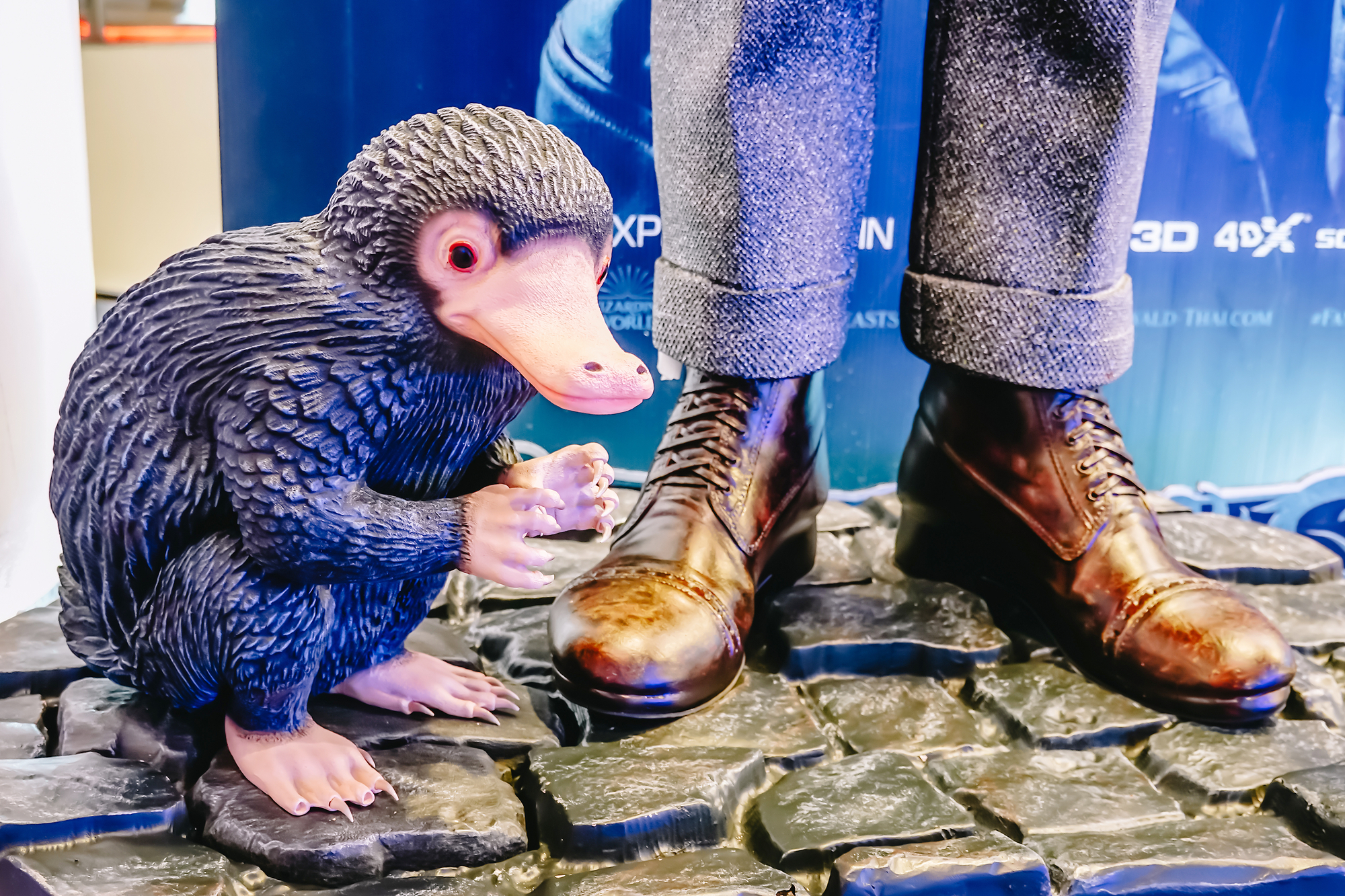Fantastic Beasts and How to Categorize Them

For a short video explaining the piece click here.
Fantastic Beasts and Where to Find Them is both a film franchise and a book. But the book doesn’t have a narrative; it is formatted like a textbook assigned in the Care of Magical Creatures course at Hogwarts. It’s ‘written’ by Newt Scamander and comes with scribbles from Harry and Ron commenting on its contents.
Before the creature entries begin there is a multipart introduction. One part, entitled “What is a Beast?” seeks to articulate a distinction between creatures who are ‘beasts’ and those that are ‘beings.’ The text notes that a being is “a creature worthy of legal rights and a voice in the governance of magical world.” But how do we distinguish between beasts and beings? This is one of the main questions central to the topic of moral status.
So, the intro asks two questions: who is worthy and how do we know? The first question seeks to determine who is in the moral community and thus deserving of rights and a voice. This is a question concerning whether an entity has the property of ‘moral standing’ or ‘moral considerability.’ The second question seeks to identify what properties an entity must have to be a member of the moral community. In other words, how does one ground a claim that a particular entity is morally considerable? We can call this a question about the grounds of moral considerability. It is the main question of the short introduction to Fantastic Beasts:
What are the properties that a creature has to have in order to be in the category ’beast’ (outside the moral community) or ‘being’ (inside the moral community)?
Attempts to resolve a question of moral considerability confront a particular problem. Call it the Goldilocks Problem. Goldilocks wants porridge that is just right, neither too hot nor too cold. We want definitions of the moral community to be just right and avoid leaving out entities that should be in (under-inclusion) and avoid including entities that should be left out (over-inclusion). When it comes to porridge it is hard to imagine one bowl being both too hot and too cold at the same time. But in the case of definitions of the grounds of moral considerability, this happens often. We can see this in the attempts to define ‘being’ in the text of Fantastic Beasts.
Fantastic Beasts looks at three definitions of the grounds of being a ‘being.’ According to the text, “Burdock Muldoon, Chief of the Wizard Council in the fourteenth century, decreed that any member of the magical community that walked on two legs would henceforth be granted the status of ‘being,’ all others to remain ‘beasts.’” This resulted in a clear case of over-inclusion. Diriclaws, Augureys, Pixies and other creatures were included in the moral community of beings, but should not have been. The text states that “the mere possession of two legs was no guarantee that a magical creature could or would take an interest in the affairs of wizard government.”
What really mattered was not the physical characteristic of being bipedal but the psychological characteristic of having interests. By focusing on the wrong property this definition accidentally included entities that did not belong.
This of course is related to a humorous story that Plato once lectured about Aristotle’s definition of a human as a featherless biped only to have Diogenes show up the next day with a plucked chicken stating “Behold! A man.”
At the same time, however, this definition is under-inclusive. Centaurs are entities that could take an interest in the affairs of wizards, but they have four legs and thus are left out. Merpeople also could take an interest in the affairs of wizards, but have no legs and thus are left out. Clearly, this definition will not do.
And it is not surprising that the definition fails. Using a physical characteristic to determine whether an entity will have the right psychological characteristics is not likely to work.
So what is a wizard to do but try to find a property more closely linked to the relevant psychological characteristic. Interests — for example, wants and needs — are often expressed linguistically: “I want chocolate chip cookies”; “I need more vegetables.” This apparently led Madame Elfrida Clagg to define a being as “those who could speak with the human tongue.” But, again, we have an example where the definition is over- and under-inclusive. Trolls could be taught to say, but not understand, a few human sentences and were included in the community but should have been excluded. Once again, the merpeople, who could only speak Mermish, a non-human language, were left out when they should have been included.
In our own world, the focus on language and other activities as proxies for cognitive traits have been used to discuss the moral status of animals (also, here). Attempts to exclude animals from the moral community did, in fact, use speech-use and tool-use as reasons to exclude animals. Descartes famously claimed in part V of the Discourse on Methods that animals did not use language but were mere automatons. But apes can use sign language, and crows, elephants, otters and other animals can use tools. So, for many who want to only include humans as in the category of ‘being,’ these activity-based definitions turn out to be over-inclusive. But again, given the incapacity of new born humans to use language or tools, they would also leave out some humans and be under-inclusive. So, using a non-psychological property (an activity) to identify a psychological property is unsurprisingly problematic.
Apparently, the wizarding world got the memo regarding the problem of these definitions by the 19th century. In 1811, Minister of Magic Grogan Stump defined a being as “any creature that has sufficient intelligence to understand the laws of the magical community and to bear part of the responsibility in shaping those laws.” The philosophical term for this set of capabilities is autonomy, at least in the way Immanuel Kant defined the term.
One way to express Kant’s’ view is that the morally considerable beings, the beings that could be called ‘persons,’ were those that had the capacity to rationally identify their interests and then have the will to execute plans to see those interests realized.
Persons are also capable of seeing that others have this capacity and thus rationally adopt rules that limit what we can do to other persons. These are the moral rules that guide our interactions that ground our rights, legal and moral, as well as give us a voice in self- and communal-governance. In other words, the term ‘being’ in Fantastic Beasts is just the text’s term for ‘moral person.’ Furthermore, the relevant psychological characteristic of persons is autonomy as defined by Kant.
There is something questionable about this Kantian view of being-hood or person-hood. On this view, persons need sophisticated cognitive abilities to be identified as persons. Any entity that lacks these cognitive abilities needed for moral judgment are non-persons and thus wholly outside the moral community. In other words, non-persons are things, have only instrumental value, and can be equated with tools: you can own them and dispose of them without morally harming them. But, this definition also excludes human infants and humans with diminished cognitive abilities, but we do not think of them as outside the moral community.
Surely these implications for humans are unacceptable. They would probably be unacceptable to the fictional Newt Scamander as well as to people who fight for animal rights. But the Kantian view is binary: you are a person/being or a beast/thing. Those who find such a stark choice unappealing can and do recognize another category between person and things. This would be something that has interests, but not interests in having a voice in governance. These entities often are vulnerable to damaging impacts of the behavior of persons and have an interest in not suffering those impacts, even if they cannot directly communicate them.
So, we need a new set of terms to describe the new possible categories of moral considerability. Instead of just the categories being/person and beast/thing, we can discuss the categories of moral agent, moral patient, and thing.
A moral agent is an entity that meets the Kantian definition of person. It is an entity who is in the moral community and also shapes it. A thing is something that does not have interests and thus is outside the moral community. But a moral patient is an entity that has interests, specifically interests against harm and for beneficence that should be morally protected. Thus, they are members of the moral community, just not governing members. So, Centaurs and Merpeople and Muggles can all be considered moral agents and thus can, if they so desire, contribute to the governance of the magical community. But even if they don’t want to participate in governance, the magical community should still recognize them as being moral patients, as beings who can be impacted by and thus whose interests should be included in the discussion of governance. The giants, trolls, werewolves in werewolf form, and pixies should at least fall into this category of patient as well. In the human world, infants, young children, and those with cognitive impairment would also fall into this category.
To sum up, then, the text of Fantastic Beasts presents a view similar to Kant’s of the grounds of moral status, but it can be improved upon by recognizing the category of moral patients. Furthermore, Fantastic Beasts clearly supports psychological accounts of the grounds of moral status over physical accounts. In other words, what matters to many questions of identity and morality are psychological properties and not physical properties or behavioral capacities. This is consistent with a theme of the Harry Potter novels where the main villains focus on the physical characteristic of whether an entity has the right blood-status to be part of the wizarding community. In other words, only a villain would solely focus on physical characteristics as a source of moral value.




